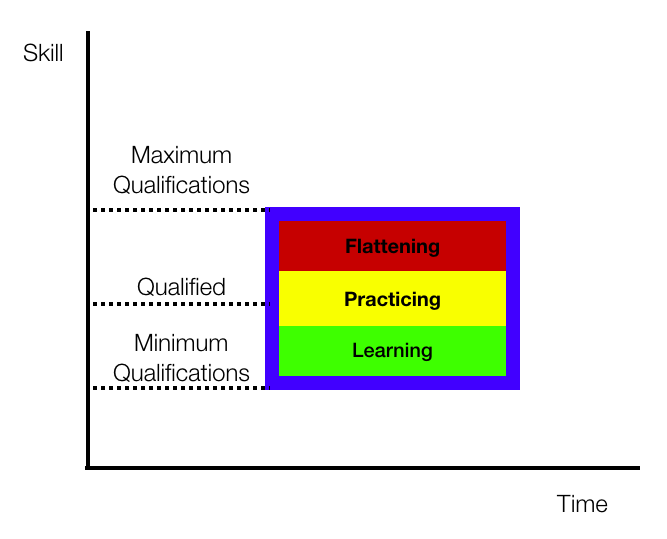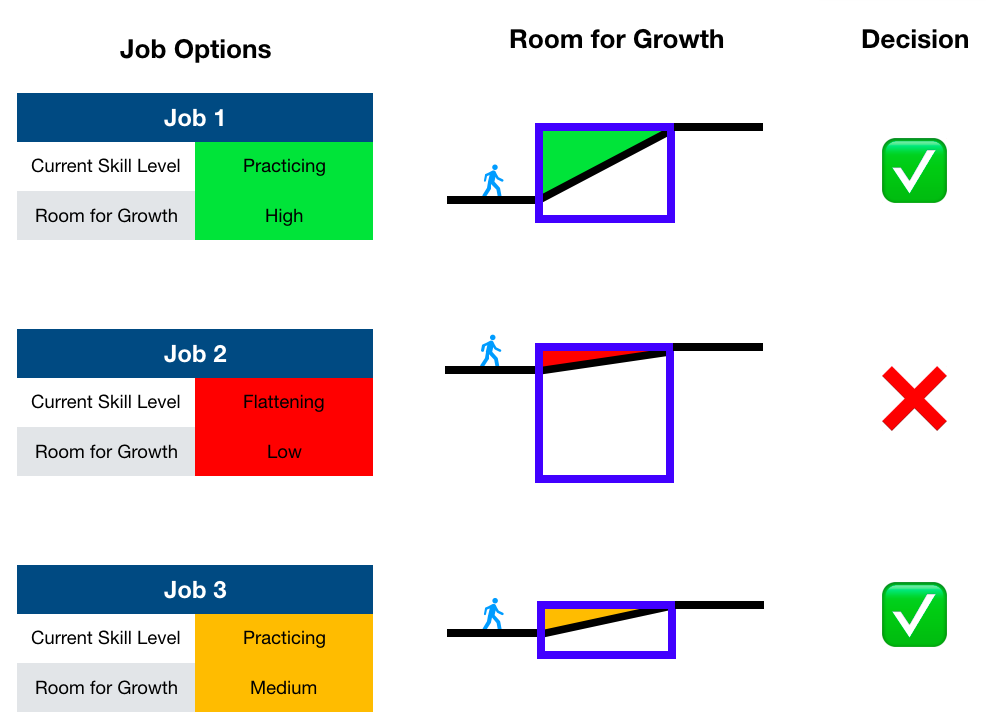How to Spot Pivotal Jobs
Use the Pivotal Growth Model to identify key career opportunities
Have you ever had a job that was pivotal to your career?
I have. It was my internship as a UX Designer at Microsoft. This role pushed me past my comfort levels, exposed me to the wonderful world of product development and taught me how to work with engineers. Leaving this internship, I felt like I had grown so much in a short period of time.
When I talk to others with similar experiences, I notice that these pivotal roles all share common qualities. I've been able to piece together these qualities together into a model to help people spot these career moves. I call it the Pivotal Growth Model This model has led me to some unintuitive lessons:
Never apply for a job you're qualified for
Room for growth is the main thing that matters.
The job description is a rubric, not a checklist.
The job description tells you the maximum you can learn in a role
Today, I want to share this model with you and walk through how I landed on these lessons.
Pivotal growth maximizes learning
Your early career is all about learning. As each year passes, you want to learn new skills that can help you tackle new problems related to your passions — or, better yet, your vision. Visualized, this may look like this:
The best way to learn more is through experiences. These may be projects, internships, volunteering, extracurriculars or apprenticeships. Each experience can help you learn skills in a set period of time.
A job is a type of experience that can help you learn. A job has a few qualities that make it distinct from other experiences:
You need to meet the minimum skill level to get a job. For example, you may need experience with Photoshop to become a designer.
While you do the job, you'll learn new skills.
When you leave the job you'll be at a new skill level. This new level can qualify you for higher-skilled jobs in the future.
Not all jobs are created equal
Like I mentioned, some jobs have been pivotal for me while others have not. This is true for everyone: some jobs will teach you more than others. Let's build out the Pivotal Growth Model to help us visualize which jobs will teach you the most.
A job can differ in three dimensions: room for growth, duration and your qualification for the role.
The most important of these is room for growth. This determines how many new skills you're able to learn from a job. In most jobs, there's a finite amount of skills you are able to learn. If you were to visualize this, the "cap" on learning is meeting the maximum qualifications for a role.
If you've ever learned a new set of skills (ex. ballet, gaming), you'll know there’s a learning curve. It usually follows the same cycle; first, you learn the base patterns. Second, you practice. Third, you refine. This is the same curve in a job. I like to think of it as three distinct phases:
Learning Phase: when you enter a new environment, there is a lot to learn. Initially, it may be overwhelming but recognize that this is the period where you're learning the most.
Practicing Phase: when you've been at the job for a while, you may be more comfortable with your responsibilities. This is the period where you'll practice everything you've learned and do the job well.
Flattening Phase: after practicing skills sufficiently, your learning curve will start to flatten. This is evident with some boredom in the role or the feeling that you may not be learning anything new.
The stage you enter the role at depends on how qualified you are for the role. This implies a key point: your room for growth is directly linked to how qualified you are. Imagine the same job done by three people of different qualification levels:
Stringing a few roles together, this may be your skill development over two years:
Two takeaways:
The more qualified you are for a role, the less skill development you can expect.
There is a cap on how you can learn from a role. This "upper bound" is usually the maximum qualifications for a role.
Use the Job Description
From the outside, it can be tough to know how well you can do a job (your qualifications) and how much you stand to learn in the role (room for growth). Fortunately, we can use the job description to give us a proxy answer for each of these.
Job descriptions often have a qualification section. Many people, including a disproportionate number of underrepresented minorities, feel the need to meet all of these criteria to apply.
This is a shame because companies are not looking for the perfect candidate. The qualifications section is not a checklist; it’s a "wishlist". You'll never meet 100% of the criteria — and if you are, you shouldn't apply for the job because there's no room to grow!
These findings are backed by a study from Robert Half, a human resource consulting firm, which says:
84% of companies are willing to hire and train a candidate who lacks the required skills
42% of applicants to a given job listing don’t meet skills requirements, but 62% of employees have been offered a position for which they were not qualified.
In summary: “Companies are challenged with finding qualified individuals who meet 100% of the job description, so they’re hiring individuals who meet a portion.”
Using the JD to determine qualifications and room for growth
Instead of a checklist, think of a job description as a rubric. They can help you identify how qualified you are for the role and how much room for growth there is.
Take all the "requirements" from the job description and assess what learning phase you’re at for the requirement. Then, look across all of the requirements to identify what phase you’re at for the job as a whole (you can take the most common phase from your self-assessed qualification). Here's an example rubric using some of the criteria from a Visual Designer role at Chipotle.
Tactically, you can create a rubric for all the jobs you are interested in. Use these rubrics to create job “boxes” and compare them. The jobs where you are currently “practicing” and there is high room for growth are the pivotal jobs you want to chase.
Landing jobs you're under-qualified for
I know that the job market is competitive, and more qualified candidates have better odds of getting the job. This is definitely true.
But I want to double down on one thing: you will learn the most from jobs you're the least qualified for.
Remember my pivotal Microsoft role? I met less than 20% of the "requirements" in the job description. This could very well have been an anomaly, so now my golden rule is if I meet 50% of the criteria and feel I can do the job well, I'm going to apply.
What are some lessons I've learned about landing roles you aren't, on paper, qualified for?
Referrals: Having someone inside the company vouching for you can be the difference between a rejection and an interview.
Create your own experiences: If you’re lacking job experience, make projects on the side that can demonstrate your skill in the area. As an Economics student wanting to work in design, I worked on website design, attended hackathons and freelanced to build a design portfolio.
Highlight differentiated strengths: A friend of mine was interviewing for a product manager role on a team that supported music creators. He was less senior than other candidates, but he highlighted his own experiences as a music producer — giving unique empathy and insights into the product. He got the job by highlighting his unique assets.
Closing lessons:
Using the Pivotal Growth Model, we can see that a pivotal job is one you're under-qualified for with significant room for growth. Having some of these experiences in your career will significantly improve your trajectory.
Summary:
Your early career is all about learning. Find the experiences that can help you learn about your field in the fastest period of time.
Look for pivotal jobs. Use the Pivotal Growth Model to see 1) how qualified you are for a role and 2) the difference between the max qualifications and your current skill level.
A job description is a rubric. Use it to understand how much you can learn in the role, given your current score.
Use all the tools in your arsenal to land roles you're under-qualified for, including referrals, working on projects and highlighting your differentiated strengths.
If you’re new to Product Life, subscribe below for concise, actionable and often surprising lessons for product managers.
Until next time,














As if you read my mind, Will! I’ll definitely use this framework moving forward. Keep it up with your amazing content!🙂
Great insights! Definitely relate a lot to this. I recently applied for a PM internship even though I haven't had any experience in a PM role before. Initially I felt scared, but felt great after the interview as it motivated me to get out of my comfort zone!